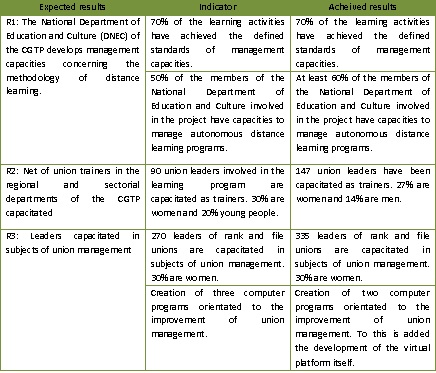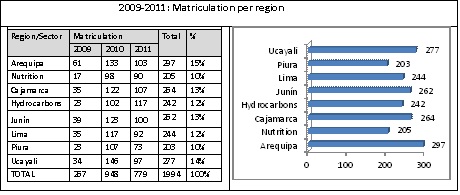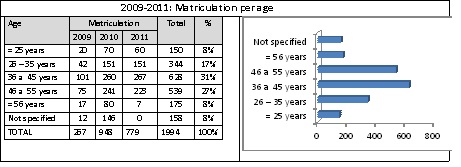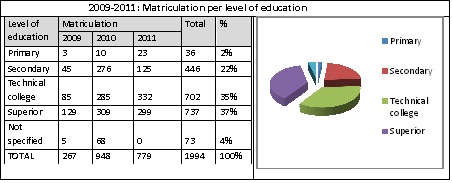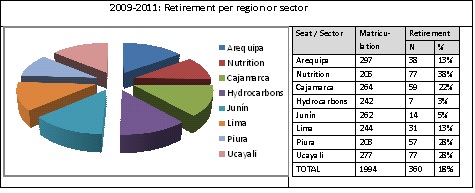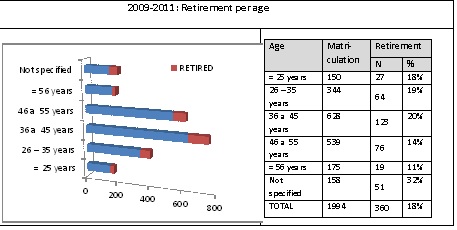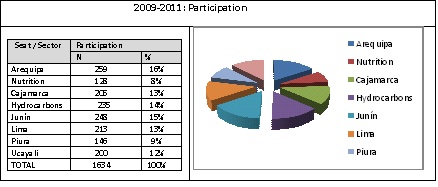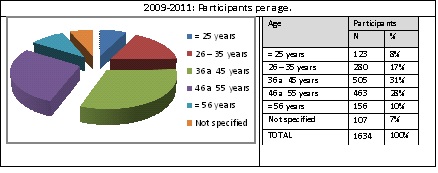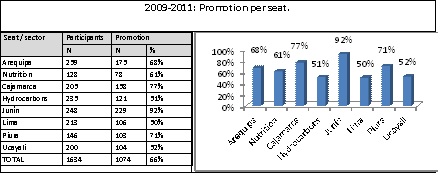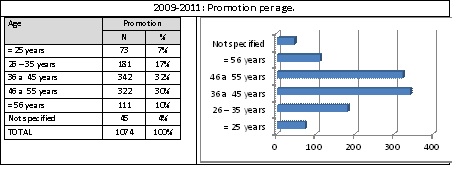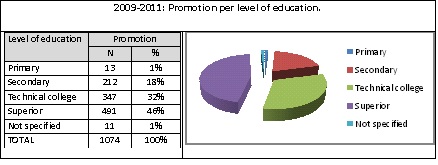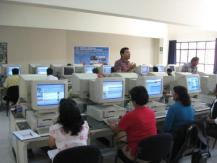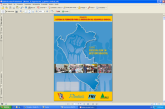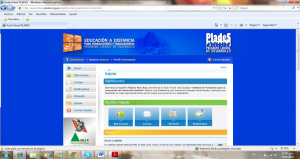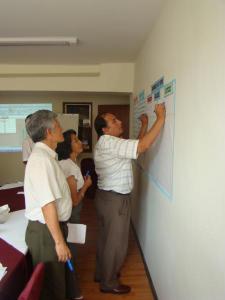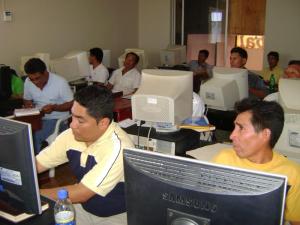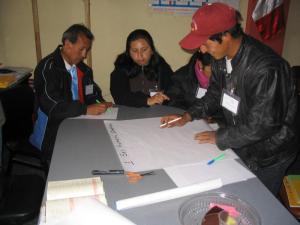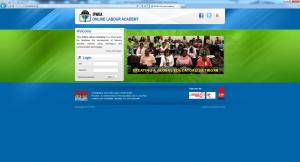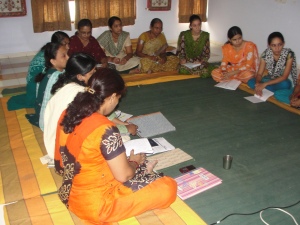III.Results
In this last entry about the project “Sistema de formación para la innovación del desarrollo sindical” we present you the achieved results.
3.1. Quantitative results[1].
This section is organized in two blocks. The first one presents a table comparing the results defined in the planning matrix and the results achieved during the execution of the project. The second block enumerates some characteristics about the participants and statistics about their academic performance in the formation programs.
3.1.1. Project results.
3.1.2. Characteristics of the participation and statistics about the academic performance.
A. Characteristics of the participation.
In the learning programs, three categories of participation are used: Matriculated, retired and participants.
- Matriculated: All participants registered in any course offered by the program.
- Retired: All matriculated participants who did not realize any of the evaluation activities.
- Participants: All matriculated participants who did realize at least one of the evaluation activities. This category is subdivided in two subcategories:
- Promoted: All participants obtaining at least the grade “C” (acceptable) as a result (11 in the vigesimal scale).
- Not promoted: All participants obtaining the grade “D” (insufficient) as a result (10 or less).
A.1. Characteristics of the matriculation.
A.2. Characteristics of retirement.
A.3 Participants.
B. ACADEMIC PERFORMANCE: Promotion
3.1.3. Results concerning the achieved capacities.
In this part, we present you a sample of the testimonials of the people involved in the project corresponding to the qualitative part of the results.
“The participants considered the subject “social dialogue” being very significative. If dialogue doesn’t exist, few changes can be generated. We saw that very few unions did start a strike lately.”(EP9)
“The course has been particularly useful for me, because it helped me to improve my vision of leadership and to make my speech much more technical, much more modern and constructive for the Workers’ Federation” (EP8)
“Now during the meetings [with the union members], I can speak to them in a more technical way, talk to them about the union movement, about our rights and we continued preparing tables”. (TA4)
“I learned to analyze the political situation we are living; I acquired knowledge about labor rights. (…) In the union context it helped me to gain the confidence of my comrades teaching them what I learned; and so they get a little bit more credibility in their union.” (P2)
“I acquired the knowledge to be able to defend myself in the working context. Otherwise, this wouldn’t have been possible because this specialty doesn’t exist. If you don’t enter in the world of unionism, this possibility does not exist; it’s as if labor rights were a subject taboo (…). But if you know about your rights, you don’t have to fear anything. You will be able to defend yourself, you have the base and the courses can give you this base.” (TA6)
“Precisely, by means of these courses, many of us leaders understood that the way to canalize the situation of the workers is by managing them (…) and this instrument permits us to get closer and to avoid possible conflicts which could arise using the traditional system.“ (T9)
“First of all, concerning the trainers, we now have at our disposal teams permitting us to encourage the union schools. We already have persons who now know how to prepare a class, how to plan it, how to elaborate its objectives, what to teach, how to measure time, how to use a didactic methodology.” (EP4)
“… [I learned] as a tutor how to work with an adult group of different persons, how to share experiences.” (TA6)
“I’m sure you know that the home workers organized themselves in unions, that they have their own law and that we also registered them to participate [in the courses].” (EP9)
“Now, there are many young people. This evolution took place parallel to the constitution of unions. The majority of the unions have young leaders, very young; they are 18, 22, 23 years old. (…) It´s their first contact with unionism. With the virtual course, they progressed and progressed.” (EP9)
Nowadays, with the Internet, one can transmit a concern at the instant, and the distance is no longer an obstacle to get to know our claims even to the president himself“ (T9)
“There are comrades who could elaborate a BLOG which permitted them to contact to the website we have [virtual platform of the CGTP], to support the federation with comments, notifications and subjects concerning the sector”. (T4)
“… for the purpose of striking, we started to use blogs to be able to communicate ourselves, to put the photos amongst others.” (TA3)
3.2. Results of the Technical-Pedagogical Advice
The Technical-Pedagogical Advice was created to improve the work of the Departments of Education and to improve their competence to implement semipresencial learning processes. Between the obtained results, we emphasize the following:
- Elaboration of the plan of institutional strengthening (2009 – 2011) of the DNEC and the respective operating plans.
- Revision and actualization of the course offerings of the National Union School “José Carlos Mariátegui” and advice to design cultural events.
- Cooperation agreement with the university “Enrique Guzmán y Valle” – La Cantuta- to promote the union capacitation of the CGTP affiliates; to share human, technological, and infrastructural resources with the aim to maximize the capacities of the participants in the distance learning courses and to support the material design and the Technical-Pedagogical Advice in the framework of the formation courses.
- Improvement of the technical-pedagogical competences of the members of the National Department and of the Regional Departments of Education and Culture of the CGTP to implement a distance learning system.
- Orientation and guide to develop strategies, to elaborate instruments and implement learning programs at a national level.
- Advice to discover the formation needs of the Regional Departments of Education and Culture.
- Elaboration of the design for the database of the National Department of Education facilitating the monitoring of the participants and of the achievements of the program.
- Development of the blog of the DNEC of the CGTP (http://dnec-cgtp.blogspot.com).
- Improvement of the management processes of the DNEC which permitted a better articulation of the learning activities and a better use of the available resources.
[1] Para mayor información, consulte el documento completo del “Informe de Sistematización” que encontrará en la sección “Documentos” del blog.

